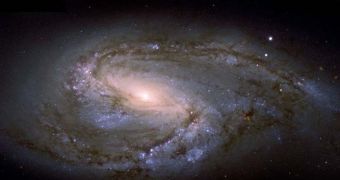One of the two theories widely proposed for explaining the formation of spiral galaxies may be wrong, either in part or altogether. The conclusion belongs to a new research paper, which analyzed both points of view objectively.
Though hundreds of billions of spiral galaxies permeate the Universe, the process underlying their formation and evolution is still mysterious to astrophysicists. The two main theories that were developed to date each works depending on the environment the galaxies live in.
In the new research paper, which has already been accepted for publication in the prestigious Astrophysical Journal, experts show that one of the two ideas is in fact not substantiated by evidence.
The first theory on spiral galaxy formation proposes that cosmic structures with nearby companion galaxies tend to catch on the spiral shape on account of the action of tidal forces pulling on them.
Things change for isolated galaxies though. In these cases, there are no companions to exert influences on the galaxy. So how is it that these massive structures take on their spiral shapes? An explanation was first proposed back in 1964.
Researchers Lin & Shu proposed that the spiral appearance was illusory. The arms were simply stationary structures, through which stars passed in all direction. The analogy often used to explain this is a traffic jam. Its location always remains the same, while cars within continue to move.
In this sense, the spiral arms telescopes see are simply areas of greater density, and as such this explanation was dubbed the Lin-Shu density wave theory, Universe Today. This idea is now coming under attack in the new paper.
The over-dense regions, Lin & Shu propose, can exist for prolonged periods of time. Others say that they form in relatively short-lived, recurrent patterns, which always return to their initial shape.
Researchers at the McMaster University in Ontario recently took matters into their own hands, trying to figure out which of the two explanations was the right one. The team was led by exper Kelly Foyle.
A sample of 12 nearby spiral galaxies was analyzed for this study, including a wide variety of spiral galaxy types. The results seem to suggest the idea that transient spiral arms break apart and reform periodically, rather than endure for prolonged periods of time.

 14 DAY TRIAL //
14 DAY TRIAL //